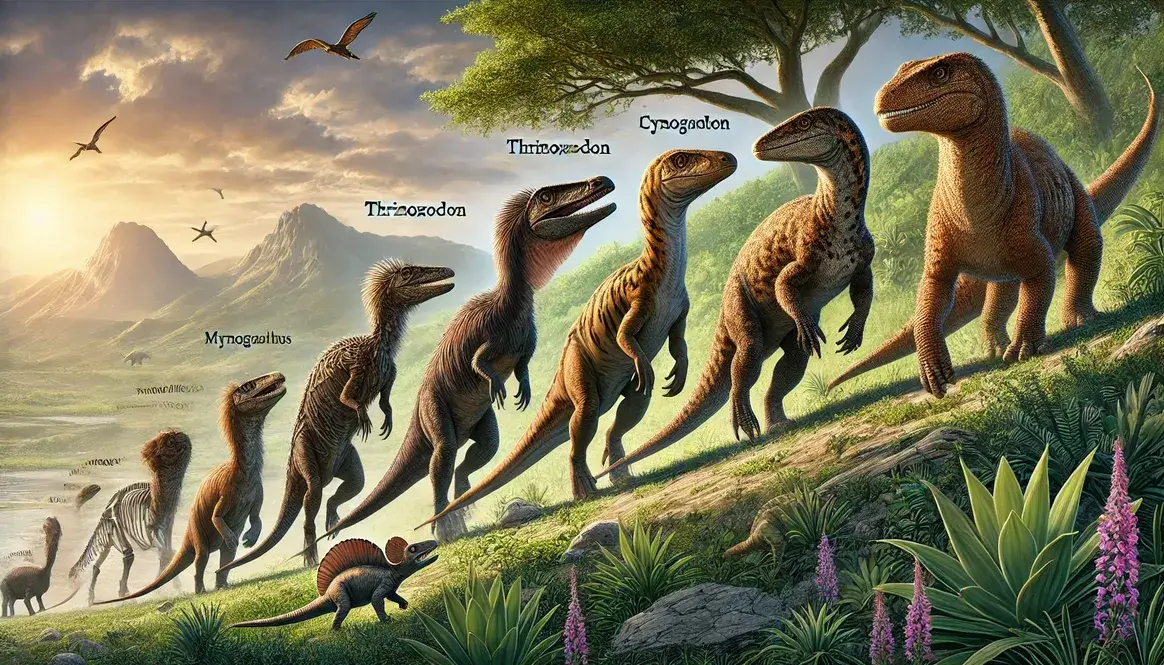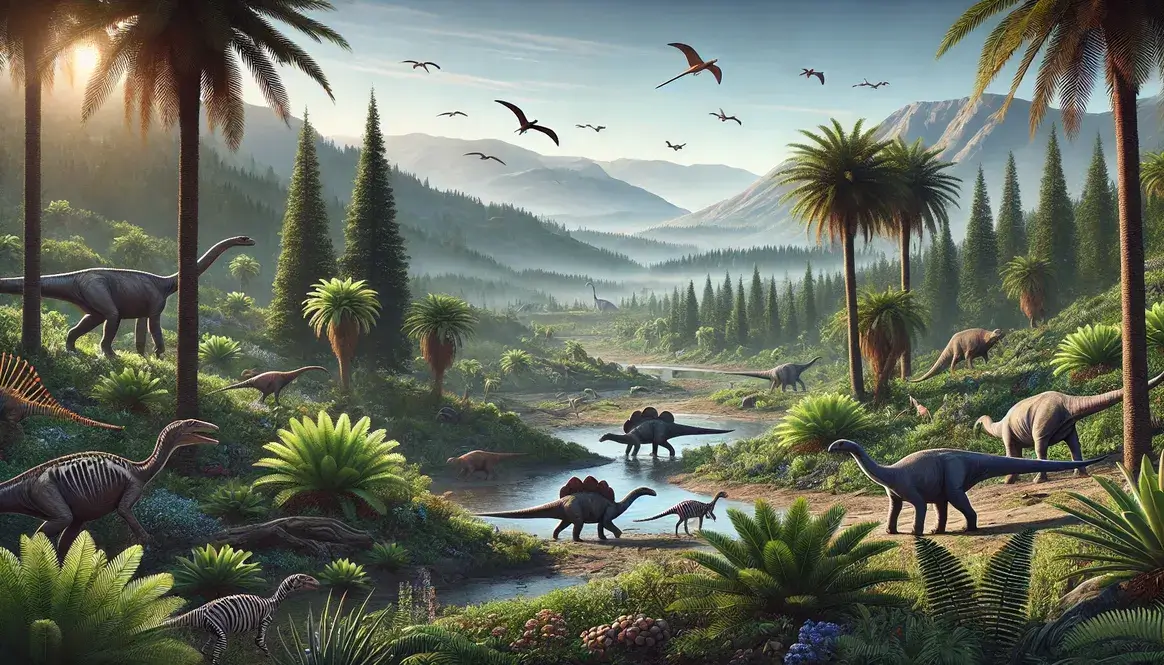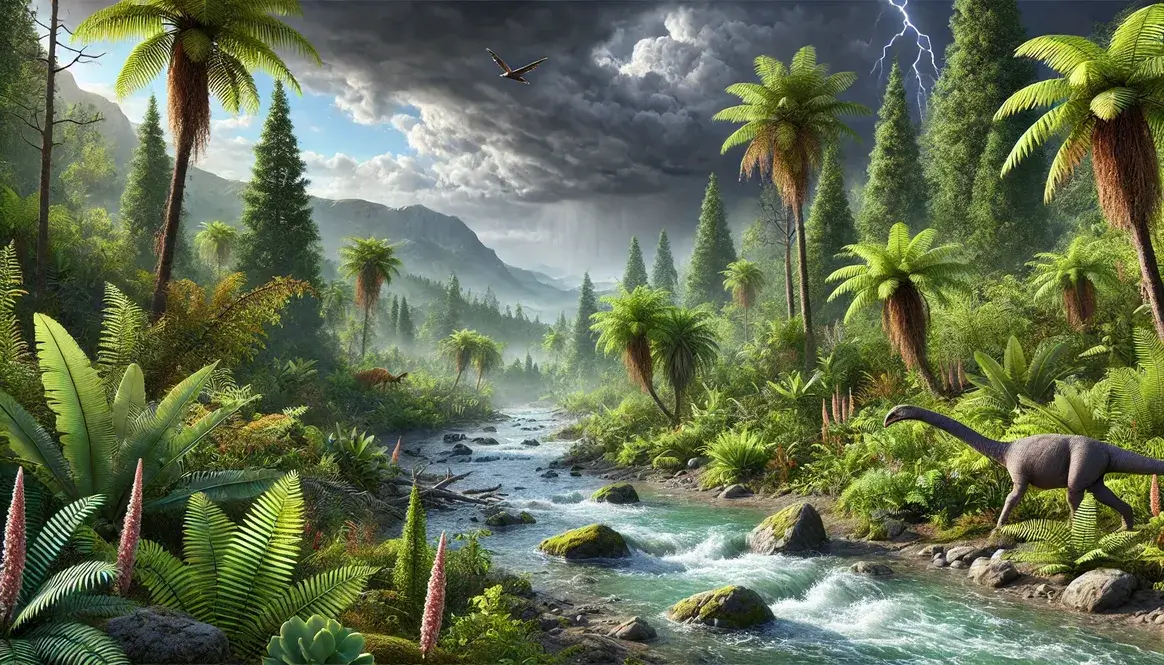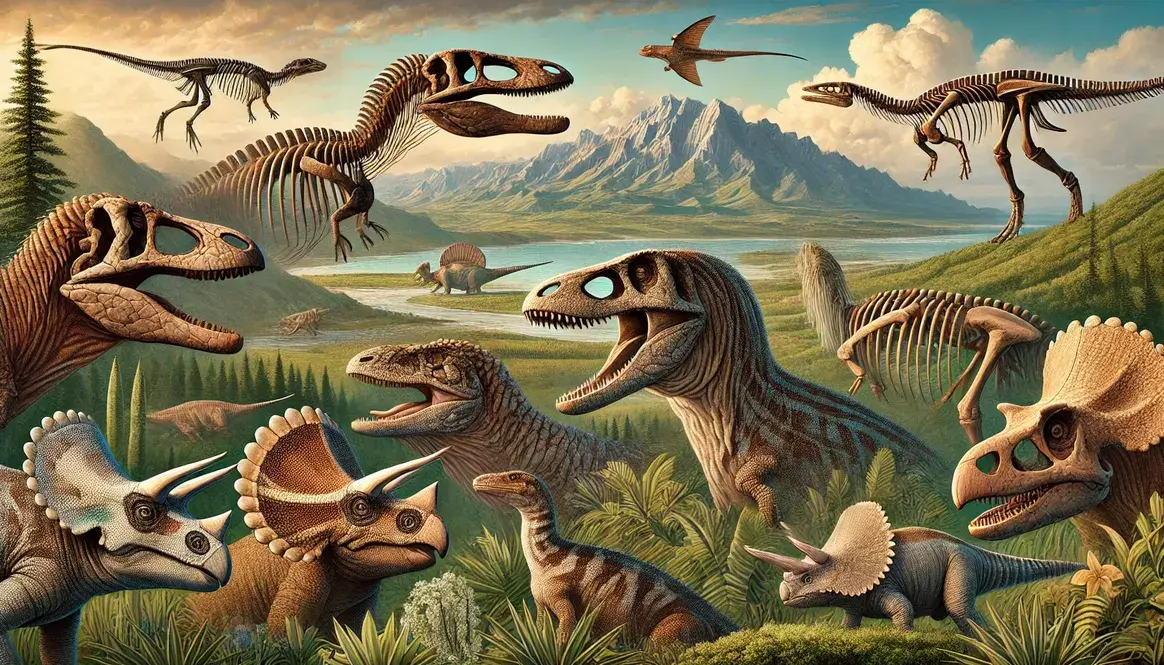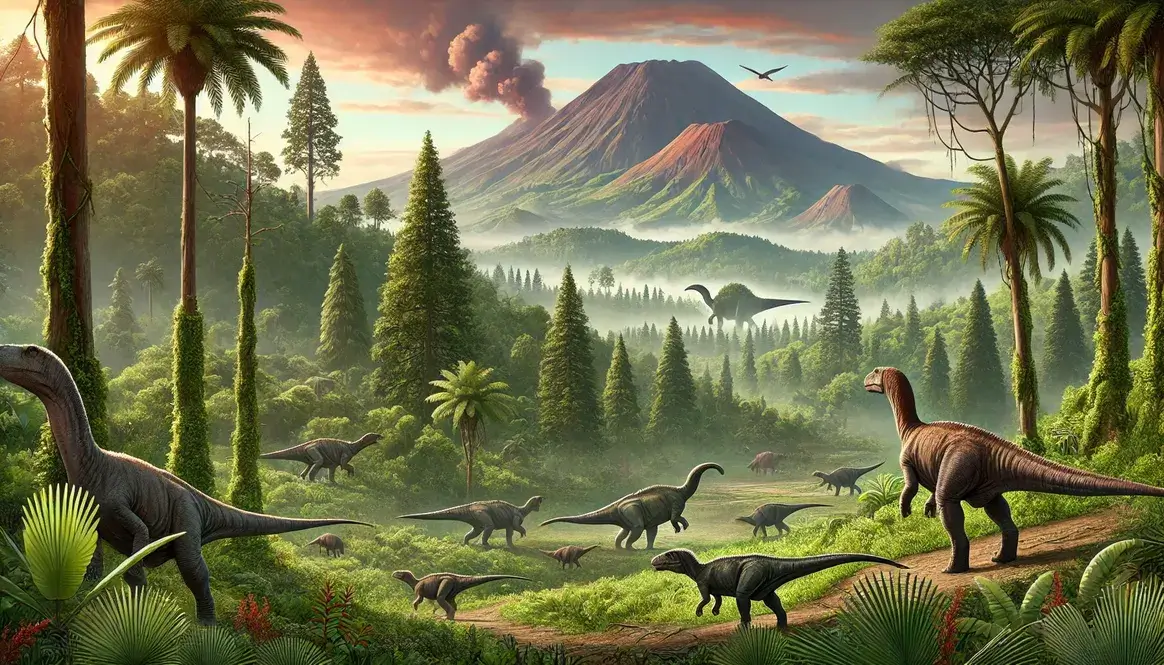The story of Triassic mammal ancestors is a tale of survival, adaptation, and evolution. It’s a journey that spans millions of years, from the aftermath of Earth’s greatest mass extinction to the dawn of the first true mammals. Let’s dive into this fascinating chapter of prehistoric life!
The Synapsid Beginnings: Early Triassic (251-247 million years ago)
The Triassic period kicked off with a bang – or rather, the aftermath of one. The Permian-Triassic extinction wiped out a whopping 95% of marine species and 70% of terrestrial vertebrate species. But as they say, when one door closes, another opens. For our Triassic mammal ancestors, this catastrophe set the stage for their incredible evolution.
Synapsids, the group that includes mammals and their ancestors, were hit hard by the extinction. But they didn’t throw in the towel. Instead, they adapted and thrived in the new Triassic world. These early Triassic synapsids, also known as “mammal-like reptiles,” had some key features that set them apart:
- A single opening behind each eye in their skull (the defining feature of synapsids)
- Differentiated teeth (different types for different functions)
- Legs positioned more under the body rather than sprawled out to the sides
Lystrosaurus: The Survivor
Enter Lystrosaurus, the ultimate survivor of the Permian-Triassic extinction. This pig-sized synapsid was like the cockroach of its day – tough, adaptable, and found practically everywhere.
| Lystrosaurus Facts | |
|---|---|
| Size | About 1 meter long |
| Diet | Herbivore |
| Key Features | Barrel-shaped body, tusks, beaked mouth |
| Distribution | Found on multiple continents (Pangaea) |
Lystrosaurus had some nifty adaptations that helped it survive:
- A beak-like mouth for cropping vegetation
- Tusks that kept growing throughout its life
- The ability to aestivate (hibernate during hot, dry periods)
But Lystrosaurus wasn’t just a survivor – it was a crucial stepping stone in mammalian evolution. Its success paved the way for more advanced mammal-like reptiles to evolve.
Thrinaxodon: Advancing Towards Mammalian Traits
As we move further into the Early Triassic, we meet Thrinaxodon, a critter that started to look a bit more like our mammalian cousins. About the size of a small dog, Thrinaxodon had some features that were decidedly more mammal-like:
- A secondary palate (which allowed it to eat and breathe at the same time)
- Differentiated teeth, including canines and molars
- Evidence of whiskers (based on snout fossils)
Thrinaxodon was a big deal in mammalian evolution. Its advanced features suggest it may have been warm-blooded and possibly even had fur. Talk about a trendsetter!
Middle Triassic Innovations (247-237 million years ago)
As we enter the Middle Triassic, things start to get really interesting for our mammal ancestors. This period saw some major evolutionary changes that brought synapsids even closer to mammalhood.
Cynognathus: The Dog-Jawed Proto-Mammal
Cynognathus, whose name literally means “dog jaw,” was a real game-changer in mammalian evolution. This carnivorous synapsid was about the size of a wolf and had some seriously mammal-like features:
| Cynognathus Features | Description |
|---|---|
| Jaw | Complex jaw joint, similar to modern mammals |
| Teeth | Heterodont (different types for different uses) |
| Limbs | More upright posture, like mammals |
| Skull | Large zygomatic arch for jaw muscle attachment |
Cynognathus’s jaw was a big deal. The complex jaw joint allowed for more efficient chewing, which meant better food processing and more energy for activities. This was a crucial step towards the mammalian way of life.
Diademodon: Specializing Teeth
While Cynognathus was perfecting its jaw, Diademodon was all about the teeth. This herbivorous synapsid had a set of chompers that would make any dentist proud:
- Incisors for nipping vegetation
- Canines for defense
- Complex cheek teeth for grinding plant matter
Diademodon’s specialized dentition was a huge leap forward in mammalian evolution. It allowed for more efficient processing of plant material, opening up new food sources and ecological niches. This dental diversity is a hallmark of mammals today, from the sharp fangs of lions to the flat molars of cows.
The evolution of these specialized teeth wasn’t just about eating – it was a sign of more precise control over body temperature. Efficient food processing meant more energy for maintaining a constant body temperature, a key characteristic of mammals.
As we move into the Late Triassic, our mammal ancestors will continue to evolve, inching ever closer to true mammalhood.
Late Triassic Advancements (237-201 million years ago)
The Late Triassic was a time of incredible diversity for our mammal ancestors. While dinosaurs were starting to make their mark, mammal-like reptiles were busy evolving into forms that were closer to true mammals than ever before. This period saw an explosion of different types of proto-mammals, each adapting to different niches in the Triassic landscape.
Tritylodontids: Almost Mammals
Tritylodontids were a group of highly advanced synapsids that lived during the Late Triassic and Early Jurassic. These critters were so mammal-like that for a long time, scientists thought they were true mammals!
| Tritylodontid Features | Description |
|---|---|
| Size | Ranged from rat-sized to dog-sized |
| Diet | Herbivorous |
| Skull | Mammal-like with specialized jaw muscles |
| Teeth | Complex, multi-cusped molars |
Tritylodontids had several mammal-like characteristics:
- A secondary palate (like Thrinaxodon before them)
- Highly specialized teeth for grinding plant material
- Possibly whiskers and fur (though this is still debated)
In the mammalian family tree, tritylodontids are considered close cousins to true mammals. They represent one of the last major groups of non-mammalian synapsids, showing just how blurry the line between “mammal-like reptile” and “true mammal” can be.
Morganucodonts: The First True Mammals?
Enter Morganucodon, a small, shrew-like creature that lived around 205 million years ago. This little guy is often considered one of the first “true” mammals, though there’s still some debate about that.
Morganucodon had some key features that set it apart from its synapsid ancestors:
- A completely new jaw joint (more on that later!)
- Three middle ear bones
- Determinate growth (it stopped growing at adulthood, like modern mammals)
The debate about whether Morganucodon was a true mammal centers around how we define “mammal.” If we go by the presence of certain skeletal features, then yes, Morganucodon makes the cut. But if we include things like giving birth to live young or producing milk, then we can’t be sure.
Either way, Morganucodon represents a crucial step in mammalian evolution. It shows us a creature right on the cusp of mammalhood, bridging the gap between the mammal-like reptiles of the past and the diverse mammals of the future.
Key Evolutionary Changes Towards Mammalian Traits
The journey from early synapsids to true mammals involved some major anatomical and physiological changes. Let’s break down some of the most important ones.
Jaw and Ear Evolution
One of the coolest transformations in mammalian evolution is the change in jaw and ear bones. In reptiles and early synapsids, the jaw joint is formed by the quadrate and articular bones. But in mammals, these bones have shrunk and moved into the middle ear, becoming the incus and malleus.
This change had two big effects:
- It created a new, more efficient jaw joint in mammals.
- It gave mammals much better hearing, especially for high-frequency sounds.
This transformation didn’t happen overnight. Fossils show a gradual shrinking of these bones over millions of years, until they finally detached from the jaw completely. Talk about an ear-ie transformation!
Teeth and Feeding Adaptations
We’ve touched on teeth a bit already, but let’s bite into this topic a little deeper. The evolution of specialized teeth was a game-changer for mammals.
Early synapsids, like many reptiles today, had simple, peg-like teeth. But over time, these teeth diversified into different types:
- Incisors for cutting
- Canines for piercing
- Premolars and molars for grinding
This dental diversity allowed mammals to eat a wide variety of foods, from tough plants to meat. It also enabled more efficient chewing, which meant better nutrient extraction from food. More energy from food meant more energy for activities like, oh I don’t know, surviving in a world full of dinosaurs!
Thermoregulation and Fur
One of the defining features of mammals is their ability to regulate their own body temperature, or endothermy. But when did this trait evolve?
Evidence suggests that some degree of endothermy was present in advanced synapsids like cynodonts. Clues include:
- Nasal turbinates (structures in the nose that help conserve water and heat)
- Upright posture (which reduces surface area and heat loss)
- High growth rates (which require a fast metabolism)
And what about fur? While we don’t have direct fossil evidence of fur in early mammal ancestors (soft tissues rarely fossilize), we do have some indirect evidence:
- Foramina (small holes) in the snout bones, which may have allowed blood supply to whiskers
- Compact body shape, which would be more efficient with an insulating layer of fur
The evolution of fur and endothermy likely went hand in hand, with each supporting the development of the other. Fur would have helped retain heat, making endothermy more efficient, while a higher body temperature would have made a fur coat more beneficial.
As the Triassic period came to a close, our mammal ancestors were well on their way to developing the traits we associate with mammals today. They were small, warm-blooded, and furry, with complex teeth and keen hearing. But their journey was far from over – the rise of the dinosaurs in the Jurassic would bring new challenges and opportunities for these early mammals.
Significant Fossil Discoveries
The story of Triassic mammal ancestors isn’t just about the creatures themselves – it’s also about the dedicated scientists who’ve unearthed their remains and the remarkable places where these fossils have been found. Let’s dig into some of the most important fossil sites that have shaped our understanding of early mammal evolution.
The Karoo Basin: A Treasure Trove of Proto-Mammals
If there’s a place that could be called the “cradle of mammal evolution,” it might just be the Karoo Basin in South Africa. This vast area, covering about two-thirds of the country, has yielded an incredible wealth of fossils from the Permian and Triassic periods.
The Karoo Basin is special for several reasons:
- Continuous deposition: Sediments were laid down continuously for millions of years, providing a detailed record of evolutionary changes.
- Excellent preservation: The dry climate has helped preserve fossils in exceptional detail.
- Accessibility: Erosion has exposed many fossil-bearing layers, making them easier for paleontologists to study.
Some of the key fossils found in the Karoo Basin include:
| Fossil | Significance |
|---|---|
| Lystrosaurus | One of the most common fossils, showing the dominance of this genus after the Permian-Triassic extinction |
| Thrinaxodon | Provides evidence of whiskers and possibly fur in early mammal ancestors |
| Cynognathus | Shows the development of a more mammal-like jaw structure |
These fossils, among many others, have been crucial in piecing together the story of how synapsids evolved into mammals.
Other Notable Fossil Localities
While the Karoo Basin is a standout, it’s not the only place where Triassic mammal ancestors have been found. Here are some other important sites:
- Ghost Ranch, New Mexico, USA: Famous for its dinosaur fossils, this site has also yielded remains of early mammals like Adelobasileus, one of the earliest known proto-mammals.
- Ischigualasto Formation, Argentina: This site, also known as “Valley of the Moon,” has provided fossils of both early dinosaurs and mammal ancestors, giving us a glimpse into their coexistence.
- Madygen Formation, Kyrgyzstan: This locality has yielded fossils of tritylodontids, providing insights into the diversity of late Triassic proto-mammals.
- Rhaetic Bone Beds, England: These deposits have produced fossils of some of the earliest true mammals, including Morganucodon.
Each of these sites adds a piece to the puzzle of mammal evolution. The global distribution of these fossils shows that mammal ancestors were widespread during the Triassic, adapting to various environments across Pangaea.
These discoveries have been crucial in understanding mammal evolution because they:
- Provide physical evidence of transitional forms
- Allow us to date evolutionary changes more accurately
- Show the diversity of proto-mammals in different environments
- Help us understand how Triassic climate and environments influenced mammal evolution
The Legacy of Triassic Mammal Ancestors
As we’ve seen, the Triassic period was a time of incredible transformation for our ancient ancestors. From the synapsids that survived the Permian-Triassic extinction to the first true mammals at the end of the Triassic, this era saw the development of many quintessential mammalian traits.
The legacy of Triassic mammal ancestors is profound:
- Adaptation and Resilience: They showed remarkable ability to adapt to new environments and challenges, setting the stage for the future success of mammals.
- Evolutionary Innovations: Key mammalian features like specialized teeth, improved hearing, and likely endothermy and fur all have their roots in Triassic proto-mammals.
- Diversification: By the end of the Triassic, mammal ancestors had diversified into various forms, occupying different ecological niches.
- Coexistence with Dinosaurs: The adaptations developed by Triassic mammal ancestors allowed early mammals to survive and thrive alongside dinosaurs in the Jurassic and Cretaceous periods.
As we look ahead to the Jurassic, we see the fruits of this Triassic evolution. Early mammals, armed with their new adaptations, began to diversify further. While they remained relatively small and nocturnal for much of the age of dinosaurs, they were quietly evolving and specializing, laying the groundwork for their eventual dominance after the extinction of the non-avian dinosaurs.
The story of Triassic mammal ancestors is a testament to the power of evolutionary processes. From humble beginnings in the wake of Earth’s greatest mass extinction, these creatures evolved into forms that would eventually give rise to all mammals – from tiny shrews to enormous whales, and everything in between. Including, of course, us humans who now study their fossilized remains with wonder and curiosity.
As we continue to make new fossil discoveries and develop new techniques for studying them, our understanding of Triassic mammal ancestors will undoubtedly grow. Each new finding helps us better appreciate the incredible journey of mammalian evolution and our own place in the grand story of life on Earth.

